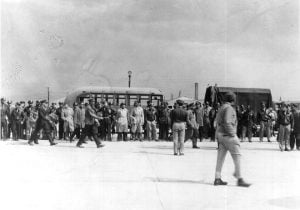Although the Tuskegee Airmen earned their namesake because of the groundbreaking training of the first black military pilots at Moton Field in Tuskegee, Alabama, the training of black pilots and support crew (collectively all known as Tuskegee Airmen) took place at several additional locations around the US, including Texas, Kentucky, Ohio, Michigan, South Carolina, Florida, Mississippi, New York, New Jersey and Indiana. One of these – Freeman Army Air Field in Indiana – became the setting for an important event in the history of the Tuskegee Airmen and ultimately the civil rights movement.
The airmen that would serve as fighter pilots were primarily trained at Moton Field from 1942 to 1945, but in 1944 an all-black group of pilots-in-training was assembled at Selfridge Field near Detroit to form the 477th Bombardment Group, that would fly B-25 bombers. The war ended before the bomber pilots saw action, but their courage and determination ended up playing a large role in the fight for civil rights, right here at home.
As is illustrated by the Tuskegee Airmen, the era of World War II saw many people of color bravely stepping up to serve their country – and fighting for that right to do so – even amidst deeply-held prejudices and the segregation that resulted from it. For the 477th, racial tensions were exacerbated by their white leadership’s insistence on enforcing strict social segregation practices, even though it violated the regulations of the time which prohibited any public building on a military installation from being used “for the accommodation of any self-constituted special or exclusive group.” The officers club – which should have served all officers regardless of race – became the battleground for the antiquated and unjust ideals of white superiority.
Early in 1945, the 477th was moved twice, first to Kentucky, then to Indiana. It was here, at Freeman Army Airfield, that the group’s Commander, Col Robert Selway, created 2 clubs – segregating “trainees” from “instructors.” This distinction was a thinly-veiled disguise for the real purpose, which was to segregate the black officers, all of which were trainees, from the instructors who were white.
There had been issues with officers’ clubs in the past, but at Freeman Field the black officers took a stand, and ended up in the history books. On April 5, 1945, black officers, in small groups, tried to enter the white-only officers club. As the night and attempts at entry progressed – and as they were subsequently turned away – the officers were met with greater resistance. Eventually, those who had tried to gain entrance were arrested, totaling 61 in that one event.
The “Freeman Field Mutiny,” as it became known, was a non-violent act of protest that went on to become a treasured and landmark point in the burgeoning civil rights movement. No one acted in a physically harmful way, although one black officer was cited for “jostling.” Still, the officers waging their peaceful protest would not go down without their voices being heard.
58 of the officers arrested were released after recommendation of the Air Inspector of the Air Force. But Col Selway was not satisfied and drafted new guidelines that would clarify the regulation of use of buildings such as officers clubs. He tried to force all of the black officers to sign a document acknowledging the still-unjust regulations, under threat of arrest for disobeying a direct order by a superior officer in a time of war, a very serious offense. Out of all the officers, only four signed, and 101 officers were arrested for their non-participation. In all, 120 officers were arrested for attempting to integrate the officer’s club on April 5 and 6, and again on April 10 and 11.
In response, the 477th was transferred back to Godman Field in Kentucky where the “offending” officers awaited trial. Fortunately, outside organizations petitioned for the drop of charges, which came to fruition on April 23, 1945. All were not exonerated though, and it would take decades to officially clear the records of all involved of any wrongdoing.
The effects of racism can be quite nuanced. Some are as blatant as denying a person the right to sit in a comfortable seat on the bus, simply because of the color of their skin. Others are subtler, like the fact that it was not until 1995 that the Tuskegee Airmen involved in the Freeman Field Mutiny would have their full records cleared and restored. This peaceful protest became an important part of our country’s history, and not just that of the Tuskegee Airmen. When they fought for the right of equal access for all, they did so on behalf of every citizen of this country and the right to freedom and liberty for all.
The CAF Red Tail Squadron is a volunteer-driven organization dedicated to educating audiences across the country about the history and legacy of the Tuskegee Airmen, America’s first black military pilots and their support personnel.






